NURSING, ECONOMICS, MATHEMATICS, BIOLOGY, ENGINEERING AND HISTORY MATERIALS
BEST TUTORING, HOMEWORK HELP, EXAMS, TESTS, AND STUDY GUIDE MATERIALS WITH GUARANTEED A+ RESALTS
I am a dedicated medical practitioner with diverse knowledge in matters of Nursing, Mathematics, and history.
- 184
- 0
- 0
Community
- Followers
- Following
184 items
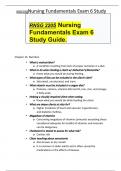
RNSG 2205 Nursing Fundamentals Exam 6 Study Guide.
RNSG 2205 Nursing Fundamentals Exam 6 Study Guide. Chapter 15: Nutrition • What is malnutrition? o A condition resulting from lack of proper nutrients in a diet. • What to do when feeding a client w/ Alzheimer’s/Dementia? o Know what you would do during feeding. • What types of fats can be included in the client’s diet? o Saturated, unsaturated, and trans • What vitamin must be included in a vegan diet? o Proteins, calcium, vitamins B12 and D, iron, zinc, and omega-3 fa...
- Exam (elaborations)
- • 9 pages •
RNSG 2205 Nursing Fundamentals Exam 6 Study Guide. Chapter 15: Nutrition • What is malnutrition? o A condition resulting from lack of proper nutrients in a diet. • What to do when feeding a client w/ Alzheimer’s/Dementia? o Know what you would do during feeding. • What types of fats can be included in the client’s diet? o Saturated, unsaturated, and trans • What vitamin must be included in a vegan diet? o Proteins, calcium, vitamins B12 and D, iron, zinc, and omega-3 fa...
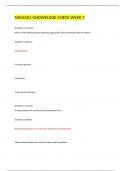
NSG6101 KNOWELDGE CHECK WEEK 7
NSG6101 KNOWELDGE CHECK WEEK 7 Question 1 (1 point) Which of the following data collection approaches does not belong with the others? Question 1 options: Questionnaire Focused interview Life history Focus group interview Question 2 (1 point) A major purpose of a pretest of an instrument is to: Question 2 options:
- Exam (elaborations)
- • 3 pages •
NSG6101 KNOWELDGE CHECK WEEK 7 Question 1 (1 point) Which of the following data collection approaches does not belong with the others? Question 1 options: Questionnaire Focused interview Life history Focus group interview Question 2 (1 point) A major purpose of a pretest of an instrument is to: Question 2 options:

NSG6101 Week 6 Knowledge Check 4/5
NSG6101 Week 6 Knowledge Check 4/5 Question 1 (1 point) Sampling may be defined as the: Question 1 options: Identification of the set of elements used for selecting study participants Process of selecting a subset of the population to represent the entire population Aggregation of study participants who meet a designated set of criteria for inclusion in the study Technique used to ensure that every element in the population has an equal chance of being included in the stu...
- Exam (elaborations)
- • 4 pages •
NSG6101 Week 6 Knowledge Check 4/5 Question 1 (1 point) Sampling may be defined as the: Question 1 options: Identification of the set of elements used for selecting study participants Process of selecting a subset of the population to represent the entire population Aggregation of study participants who meet a designated set of criteria for inclusion in the study Technique used to ensure that every element in the population has an equal chance of being included in the stu...
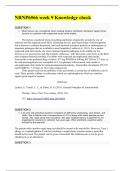
NRNP6566 week 9 Knowledge check
NRNP6566 week 9 Knowledge check The factors considered when prescribing antibiotics empirically include the site of infection and the organism most likely colonizing the site, prior knowledge of microorganism that is known to colonize the patient, and local bacterial resistance patterns or antibiograms of important pathogens that are available in most hospitals (Leekha et al., 2011). For a patient suspected with otitis media, the most common bacterial pathogens in the middle ear are Streptoco...
- Exam (elaborations)
- • 6 pages •
NRNP6566 week 9 Knowledge check The factors considered when prescribing antibiotics empirically include the site of infection and the organism most likely colonizing the site, prior knowledge of microorganism that is known to colonize the patient, and local bacterial resistance patterns or antibiograms of important pathogens that are available in most hospitals (Leekha et al., 2011). For a patient suspected with otitis media, the most common bacterial pathogens in the middle ear are Streptoco...
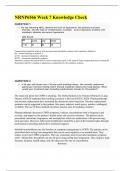
NRNP6566 Week 7 Knowledge Check
NRNP6566 Week 7 Knowledge Check pH pCO2 pO2 HCO3 7.36 30 80 15 Compensated metabolic acidosis with no hypoxemia (metabolic acidosis with respiratory alkalosis) Ph – normal (leaning on acidosis ) pCO2 – decreased (respiratory alkalosis) HCO3 – decreased (rmetabolic acidosis) Metabolic acidosis (decreased HCO3) with no hypoxemia (pO2 is 80, normal) Fully compensated due to normal pH. Respiratory (pCO2) is leading to alkalemia to compensate for the metabolic acidosis. ...
- Exam (elaborations)
- • 7 pages •
NRNP6566 Week 7 Knowledge Check pH pCO2 pO2 HCO3 7.36 30 80 15 Compensated metabolic acidosis with no hypoxemia (metabolic acidosis with respiratory alkalosis) Ph – normal (leaning on acidosis ) pCO2 – decreased (respiratory alkalosis) HCO3 – decreased (rmetabolic acidosis) Metabolic acidosis (decreased HCO3) with no hypoxemia (pO2 is 80, normal) Fully compensated due to normal pH. Respiratory (pCO2) is leading to alkalemia to compensate for the metabolic acidosis. ...
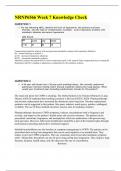
NRNP6566 Week 7 Knowledge Check
NRNP6566 Week 7 Knowledge Check pH pCO2 pO2 HCO3 7.36 30 80 15 Compensated metabolic acidosis with no hypoxemia (metabolic acidosis with respiratory alkalosis) Ph – normal (leaning on acidosis ) pCO2 – decreased (respiratory alkalosis) HCO3 – decreased (rmetabolic acidosis) Metabolic acidosis (decreased HCO3) with no hypoxemia (pO2 is 80, normal) Fully compensated due to normal pH. Respiratory (pCO2) is leading to alkalemia to compensate for the metabolic acidosis. ...
- Exam (elaborations)
- • 7 pages •
NRNP6566 Week 7 Knowledge Check pH pCO2 pO2 HCO3 7.36 30 80 15 Compensated metabolic acidosis with no hypoxemia (metabolic acidosis with respiratory alkalosis) Ph – normal (leaning on acidosis ) pCO2 – decreased (respiratory alkalosis) HCO3 – decreased (rmetabolic acidosis) Metabolic acidosis (decreased HCO3) with no hypoxemia (pO2 is 80, normal) Fully compensated due to normal pH. Respiratory (pCO2) is leading to alkalemia to compensate for the metabolic acidosis. ...

NSG 6101 W5 Knowledge Check.
NSG 6101 W5 Knowledge Check. Question 1 The research design for a quantitative study involves decisions with regard to the following Whether there will be a theoretical context Whether there will be an intervention What types of comparisons will be made
- Exam (elaborations)
- • 5 pages •
NSG 6101 W5 Knowledge Check. Question 1 The research design for a quantitative study involves decisions with regard to the following Whether there will be a theoretical context Whether there will be an intervention What types of comparisons will be made
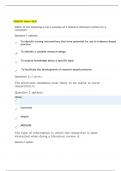
NSG6101 Week 3 QUIZ
NSG6101 Week 3 QUIZ Which of the following is not a purpose of a research literature review for a consumer? Question 1 options: To identify nursing interventions that have potential for use in evidence-based practice To identify a suitable research design To acquire knowledge about a specific topic To facilitate the development of research-based protocols Question 2 (1 point) The electronic database most likely to be useful to nurse researchers is Question 2 option...
- Exam (elaborations)
- • 3 pages •
NSG6101 Week 3 QUIZ Which of the following is not a purpose of a research literature review for a consumer? Question 1 options: To identify nursing interventions that have potential for use in evidence-based practice To identify a suitable research design To acquire knowledge about a specific topic To facilitate the development of research-based protocols Question 2 (1 point) The electronic database most likely to be useful to nurse researchers is Question 2 option...
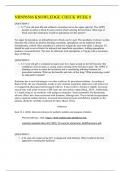
NRNP6566 KNOWLEDGE CHECK WEEK 8
NRNP6566 KNOWLEDGE CHECK WEEK 8 Ketamine has several advantages over other sedatives for procedural sedation. According to Buck (2016), the use of ketamine results in only minimal respiratory depression with preserved or exaggerated pharyngeal and laryngeal reflexes. It also results to normal or slightly increased muscle tone with minor increase in BP, heart rate and cardiac output (Buck, 2016). Additionally, it is rapid acting as an anesthetic with analgesic properties. Some potentially ...
- Exam (elaborations)
- • 6 pages •
NRNP6566 KNOWLEDGE CHECK WEEK 8 Ketamine has several advantages over other sedatives for procedural sedation. According to Buck (2016), the use of ketamine results in only minimal respiratory depression with preserved or exaggerated pharyngeal and laryngeal reflexes. It also results to normal or slightly increased muscle tone with minor increase in BP, heart rate and cardiac output (Buck, 2016). Additionally, it is rapid acting as an anesthetic with analgesic properties. Some potentially ...
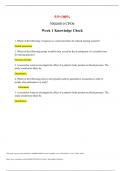
5/5=100% NSG6010 CPO6 Week 1 Knowledge Check
5/5=100% NSG6010 CPO6 Week 1 Knowledge Check
- Exam (elaborations)
- • 1 pages •
5/5=100% NSG6010 CPO6 Week 1 Knowledge Check
